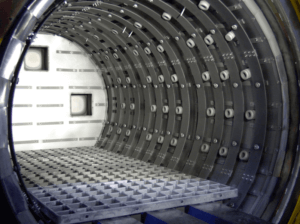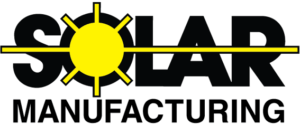Critical Areas In Vacuum Furnace Preventive Maintenance
Regularly scheduled maintenance of vacuum furnaces ensures a safe operational environment for the equipment and the people working with the furnace.
There are a variety of vacuum furnace components and concerns that need to be properly and periodically maintained including:
- Furnace chamber
- Leak prevention
- Hot zone functionality and integrity
- Bake-out and leak rate checking
- Power supply
- Vacuum pumps
- Water lines and supply
- Gas lines and supply
- Keeping accurate maintenance records
Following general guidelines in each of these areas will minimize the potential for problems in the future.
Furnace Chamber
It is critical that the chamber be kept as clean as possible. After each process cycle, the operator should wipe the bottom of the furnace with a clean, lint-free rag to remove all water and debris that has collected. If there is considerable build-up of contaminants, the furnace should be brushed or blown out with an air hose.
The chamber should also be examined for scorch marks known as “hot spots.” Hot spots indicate that the water flowing in the water jacket is not properly cooling the vessel. This must be corrected before making additional runs in the furnace. Correct treatment of the cooling water is essential to prevent clogging or corrosion of the vacuum chamber, diffusion pump coils, power feed-throughs, VRT power transformers and main gas cooling heat exchanger.
Preventing Leaks
Most leaks occur at joints (welded, brazed or soldered) and at seals (O-Rings or gaskets) between flanges. The most frequent leak problem occurs on the O-ring seal for the front door. The O-ring is subject to flattening and, if this occurs, must be replaced. It also needs to be kept clean. After each cycle, the operator should wipe the O-ring with a clean, soft rag.

Monthly, the door O-ring needs to be:
- Checked for cracks, gouges, and the retention of elasticity.
- Cleaned with a lint free cloth and have an application of a thin film of vacuum grease until there is a sheen on the surface. It is important to be careful not to apply too much grease.
Other O-rings on the system that are bolted between flanges only need to be changed if it is determined that a leak exists at the joint or the joint is disassembled for maintenance. These O-rings can be replaced using the same steps as the door O-ring. Any pipe thread fittings in vacuum or gas must be coated with a Teflon dope such as “Swak.” Teflon tape is not permitted as it will extrude and eventually leak.
Hot Zone Functionality and Integrity

- Signs of arcing due to loose heating element connections
- Broken or cracked elements
- Loose insulation
- Loose nozzles
- Damage to process thermocouples
Any loose connections should be immediately tightened or taken apart and repaired prior to any further cycles being run.
The hot zone should be cleaned on a regular schedule by performing a bake-out cycle. However, if any of the following conditions exist between regularly scheduled bake-outs, an additional bake-out should be performed:
The insulators have changed in color. This could be a result of metallization which will cause the insulators to short out the heating elements if they are not replaced. Heat element resistance to ground (chamber) should be greater than 10 ohms. A resistance reading less than 2 ohms may result in heating element arcing and failure. This test is only performed with all power turned off to the furnace.
- Signs of build-up inside the gas nozzles.
Bake-Out and Leak Rate Checking
A bake-out cycle should be scheduled for the furnace on a regular basis based on the number of cycles and the types of cycles being processed. It should also be performed when signs of contamination occur between regular bake-out runs. In addition, some users will consider a bake-out cycle prior to processing critical work to minimize possibility of contamination.
A typical bake-out cycle involves heating the furnace to 2400oF, holding for two (2) hours, vacuum cooling to 1800oF and gas fan cooling to ambient temperature. This should result in a very clean internal for the start of the next process cycle.
The running of a bake-out cycle is the ideal time to perform a leak rate check of the furnace. The leak rate is the rise in vacuum level over a period of time, i.e., Microns/Hour.

Then, subtract the original vacuum reading from the 15 minute reading and multiply by 4. This will calculate the leak rate per hour of the vacuum chamber. For most applications, a leak rate of 20 Microns/Hour is acceptable. However, a very tight, vacuum degassed, furnace will achieve a rating of less than 5 Microns/Hour with many achieving a level of less than 1 Micron/Hour.
Power Supply Maintenance
Generally, power supplies require a minor amount of preventive maintenance. However, ”best practices” for their upkeep include having users:
- Check that primary and secondary wiring and cables are tight and free from overheating, at least yearly.
- Inspect for proper air/water cooling of the supply. For water-cooled supplies, refer to the user’s manual for recommended water quality and flushing of the system. VRT power transformers must have their water cooling hoses replaced at least every five years.
- Inspect control relays and contactors for contact pitting or arcing, which could result in contact welding.
- Verify that power supply voltage is maintained within reasonable limits, ± 8%, to insure against overloading or under-heating.
- Keep the power supply clean. Do not allow a buildup of dust, dirt, or moisture to collect anywhere inside the power supply enclosure.
Vacuum Pumps
The following maintenance items apply to all types of pumps:
- Check mounting bolts for tightness.
- Investigate for unusual noise or vibration if noticed.
- Check/tighten vibration couplings
- Install all guards before running.
- Check oil levels and for signs of contamination. Change oil if necessary.
- Roughing Pump
Additional items to the above that should be checked on the roughing pump include:
- Check pulleys and belts to ensure proper tightness.
- Drain exhaust line filter daily and check for proper ventilation.
- Clean oil reservoir, valve deck and solenoid valve every six months.

The oil on the roughing pump needs to be changed at regular intervals, typically monthly based on reasonable operation. Oil level should be mid-sight glass level with the pump running and a vacuum level of less than 1 Torr.
- Holding Pump
The holding pump should be inspected with the same method noted for the rouging pump and its oil must be changed on a monthly basis. The correct oil level is mid-sight glass with pump running and vacuum level less than 1 Torr.
- Booster pump
- Clean regularly.
- Check oil levels and look for signs of contamination. Change oil if necessary.
- Check and replace belts or spider as applicable.
- Re-time booster as needed.
- Insure that the pump housing is not distorted due to mounting or misaligned pipe connections.
- Change oil at least every six months.
- Diffusion Pump
- Test for correct water flow from the water inlet at the top of the pump and the drains at the foreline.
- Ensure heating elements are tight and working within electrical parameters with equal amperage on all phase lines.
- Check oil level and look for signs of contamination. Drain and change oil every six months with the pump cold. On refilling, use the correct charge volume. Do not rely on the sight glasses.
- Clean pump when needed by dropping pump, removing jet assembly and thoroughly cleaning the inside prior to charging with new oil.
Caution: Vacuum pump oils are specific to the Diffusion Pump, the Holding Pump, the Vacuum Booster Pump, and the Mechanical Roughing Pump. Do not interchange these vacuum pump oils and store them in a location marked for each specific pump. In addition, educate maintenance and operating personnel about their proper use.
Water Lines and supply
- Monthly – check ball indicators. The balls should move freely when there is proper flow. There should be no blockage or sediment buildup on any of the drain lines. Inspect the drain lines for acceptable temperatures. Outlet temperature should be less than 130oF when hot zone is at temperature.
- As required – check and clean the pressure regulator and strainer.
Gas Lines and Supply
- Yearly – check gas line from supply tank to furnace backfill valve and partial pressure valve by applying a soap solution with a brush. If a leak is present, the soap solution will bubble. If necessary, remove ball valve and clean.
Accurate Maintenance Records
It is essential that accurate maintenance records be kept to assure maximum performance from the vacuum furnace. Typical record keeping might look like the following:
Chart 1
| Monthly Function | Furnace One | Furnace Two | Furnace Three |
| Change Roughing Pump Oil | |||
| Change Holding Pump Oil | |||
| Check Vacuum Booster Oil | |||
| Check Holding Pump Oil | |||
| Drain Exhaust Line Filter | |||
| Grease Main Valve | |||
| Clean Air Filters | |||
| Check Belts | |||
| Check Water Flow Ball Indicators | |||
| Check Integrity of Door O-ring Seal | |||
| Check Air Line Oilers | |||
| Inspect entire Hot Zone |
Chart 2
| Six month/Yearly function | Furnace One | Furnace Two | Furnace Three |
| Change Diffusion Pump Oil | |||
| Change Vacuum Booster Oil | |||
| Replace Door O-ring seal (Three Months) | |||
| Roughing Pump belt replacement (Year) | |||
| Clean Roughing Pump Reservoir (Year) | |||
| Check all Flowmeters (Year) | |||
| Do Electrical Cleaning |
Obviously, the maintenance of a vacuum furnace is an on-going function that must be continually evaluated. Following the suggestions outlined for each of the critical maintenance areas will assist with the keeping the furnace in continued operation and processing successfully for years to come.
Written By:
Real J. Fradette – Senior Technical Consultant – Solar Atmospheres Inc.
William R. Jones – CEO – Solar Atmospheres Inc.

 The insulators have changed in color. This could be a result of metallization which will cause the insulators to short out the heating elements if they are not replaced. Heat element resistance to ground (chamber) should be greater than 10 ohms. A resistance reading less than 2 ohms may result in heating element arcing and failure. This test is only performed with all power turned off to the furnace.
The insulators have changed in color. This could be a result of metallization which will cause the insulators to short out the heating elements if they are not replaced. Heat element resistance to ground (chamber) should be greater than 10 ohms. A resistance reading less than 2 ohms may result in heating element arcing and failure. This test is only performed with all power turned off to the furnace.